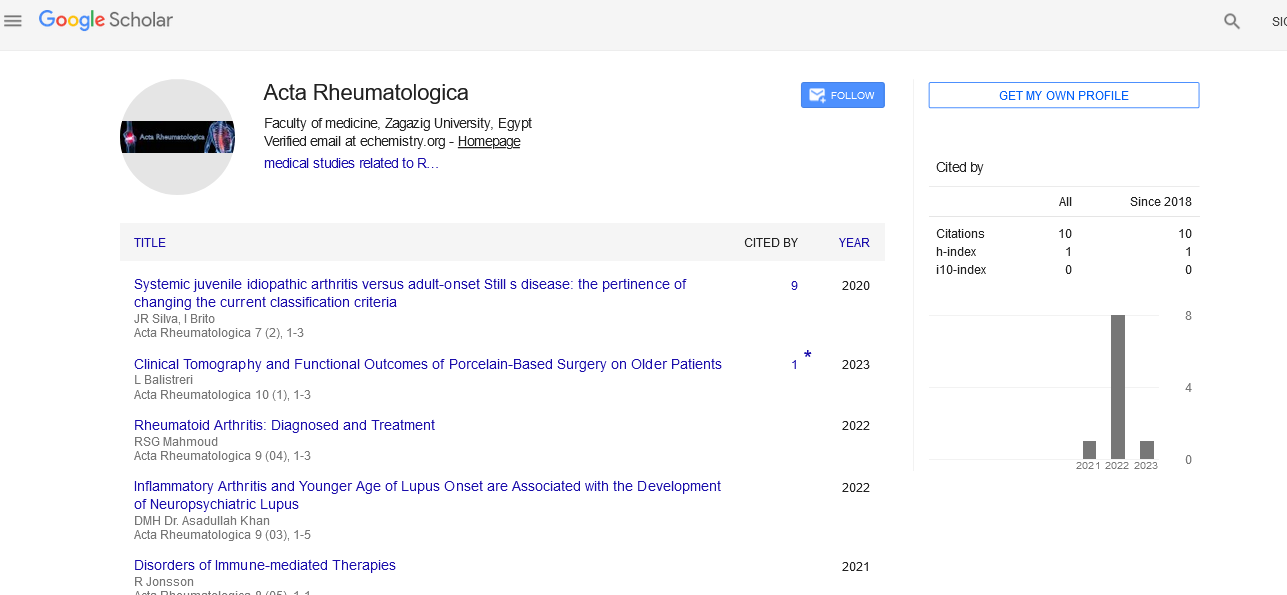Perspective - (2023) Volume 10, Issue 5
The Unsung Heroes Within: A Comprehensive Journey through the World of Bones
Kassem Sharif*
Department of Medical and Healthcare, Ulm University, Malaysia
*Correspondence:
Kassem Sharif, Department of Medical and Healthcare, Ulm University,
Malaysia,
Email:
Received: 01-Sep-2023, Manuscript No. ipar-23-14249;
Editor assigned: 09-Apr-2023, Pre QC No. ipar-23-14249 (PQ);
Reviewed: 19-Sep-2023, QC No. ipar-23-14249;
Revised: 27-Sep-2023, Manuscript No. ipar-23-14249 (R);
Published:
05-Oct-2023
Description
Bones, the structural framework of the human body,
often remain in the shadows of our health awareness until
something goes amiss. These sturdy yet dynamic
structures support us, protect vital organs, anchor
muscles, and play a crucial role in the blood-forming
process. This comprehensive article embarks on a journey
through the captivating world of bones, exploring their
significance, the intricacies of bone physiology,
breakthroughs in the field, and the critical role they play
in our overall health and mobility.
The significance of bones
Bones hold a unique significance in our lives, extending
well beyond the realm of structural support:
Support and protection: Bones form the body's
framework, providing support for muscles and protecting
delicate internal organs like the brain, heart, and lungs.
Mobility: Bones, along with muscles and joints, facilitate
movement, allowing us to walk, run, dance, and perform
a myriad of activities.
Blood cell production: Bone marrow, the soft, spongy
tissue within bones, is the epicenter of blood cell
production, generating red blood cells, white blood cells,
and platelets that are essential for oxygen transport,
immunity, and clotting.
Mineral storage: Bones serve as a reservoir for essential
minerals, particularly calcium and phosphorus, which are
released into the bloodstream to maintain mineral balance.
To appreciate the intricacies of bone health, we must
delve into its key components:
Bone structure: Bones consist of two primary types:
Compact (cortical) bone, the hard outer layer, and
cancellous (trabecular) bone, the spongy inner layer.
Bone cells: Various specialized cells are involved in bone
remodeling, including osteoblasts (bone-building cells),
osteoclasts (bone-resorbing cells), and osteocytes (mature
bone cells).
Bone remodeling: Bone is a dynamic tissue that
constantly undergoes remodeling, with old bone being
resorbed by osteoclasts and new bone being formed by osteoblasts.
Hormonal regulation: Hormones like Parathyroid
Hormone (PTH) and calcitonin regulate calcium levels
in the blood and play a pivotal role in bone health.
Breakthroughs in bone health
The field of bone health has seen remarkable
breakthroughs that have enhanced our understanding
and management of bone disorders:
Dual-energy X-ray Absorptiometry (DXA): DXA scans
have revolutionized the diagnosis of osteoporosis by
providing precise measurements of bone density,
enabling early intervention and treatment.
Biopharmaceuticals: The development of biopharmaceuticals,
including bisphosphonates, has significantly improved the
management of osteoporosis and bone metastases in cancer.
Bone marrow transplantation: Advances in bone
marrow transplantation have extended the treatment
possibilities for various hematologic diseases, such as
leukemia and multiple myeloma.
Bone regeneration: Research in the field of regenerative
medicine is offering hope for the regeneration and repair
of bone tissue, potentially revolutionizing treatments for
fractures and bone defects.
The role of bone health in modern
healthcare
Bone health plays a pivotal role in modern healthcare,
contributing to a range of services and initiatives:
Prevention and early intervention: Preventive
measures, including dietary calcium and vitamin D
intake, weight-bearing exercises, and early diagnosis of
bone disorders, are essential to maintain bone health.
Orthopedics: Orthopedic surgeons specialize in the
treatment of bone and joint disorders, providing
surgical interventions such as fracture repairs, joint
replacements,
and bone deformity corrections.
Osteoporosis management: Healthcare professionals,
including endocrinologists and rheumatologists, diagnose
and treat osteoporosis, often with medications and
lifestyle counselling.
Bone marrow transplantation: Hematologists and
oncologists oversee bone marrow transplantation for
hematologic disorders, coordinating complex treatments to
ensure the best outcomes for patients.
Research and innovation: Ongoing research in bone
health leads to the development of new medications,
regenerative therapies, and diagnostic tools for various
bone conditions.
Challenges and future directions in bone
health
The field of bone health faces several challenges, including
the increasing prevalence of osteoporosis and fractures
associated with an aging population, as well as the need
for more accessible and cost-effective treatments. The
future of bone health holds several promising directions:
Personalized medicine: Advances in genetics and
precision medicine will enable tailored treatment plans for
individuals with bone disorders.
Regenerative therapies: Continued research into regenerative
approaches, such as stem cell-based therapies, may offer new
options for bone regeneration and fracture healing.
Telemedicine: Telehealth services are expanding access to
bone health care, particularly for underserved populations.
Fracture prevention programs: Comprehensive programs
aimed at fall prevention and fracture risk assessment can
significantly reduce the burden of osteoporotic fractures.





